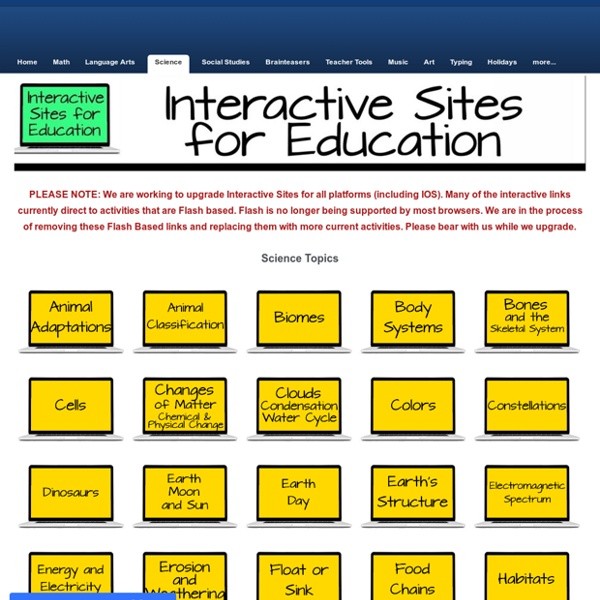



http://interactivesites.weebly.com/science.html
Related: Interactives • ScienceMagnifying the Universe Embed this infographic on your site! <iframe width="500" height="323" scrolling="no" src=" frameborder="0" allowfullscreen></iframe><br />Copyright 2012. <a href=" the Universe</a> by <a href=" Sleuth</a>. Impact of habitat loss on species Habitat loss is probably the greatest threat to the variety of life on this planet today. It is identified as a main threat to 85% of all species described in the IUCN's Red List (those species officially classified as "Threatened" and "Endangered"). Increasing food production is a major agent for the conversion of natural habitat into agricultural land. Why is it happening? Forest loss and degradation is mostly caused by the expansion of agricultural land, intensive harvesting of timber, wood for fuel and other forest products, as well as overgrazing.
Peppered Moth Simulation Name:______________________________________________ Objective: Simulate changes in moth population due to pollution and predation, and observe how species can change over time. Introduction: Charles Darwin accumulated a tremendous collection of facts to support the theory of evolution by natural selection. One of his difficulties in demonstrating the theory, however, was the lack of an example of evolution over a short period of time, which could be observed as it was taking place in nature. Although Darwin was unaware of it, remarkable examples of evolution, which might have helped to persuade people of his theory, were in the countryside of his native England.
200th Activity Book For 200 years, NOAA has been focused on delivering "science, service, and stewardship." Making this happen leads the people of NOAA from the edge of space to the bottom of the ocean. To help you learn more about your world and how NOAA helps you explore, understand, and protect our Earth, we've put together this book with 43 different activities. Plants And Animals Hunting on the wing, an osprey appears to glide effortlessly over the water. These large raptors have narrow wings, which they bend when soaring and scanning for fish beneath the surface. Ospreys have dark brown feathers on their back and a white belly. The head is also white, with a brown eye stripe extending from the eye to the shoulders. The undersides of the wings are white except for dark wrist patches and brown-barred flight feathers.
Deep Time : A History of the Earth - Interactive Infographic Life on the planet started astonishingly early. The first living organisms, in the current model of evolution, are thought to be Prokaryotes1. The oldest known fossilised prokaryotes have been dated to approximately 3.5 billion years ago, only 1 billion years after the formation of the Earth's crust. Eukaryotes2 are more advanced organisms with complex cell structures, each of which contains a nucleus. Although incredibly hard to determine their origin, they are thought to have developed 1.6–2.1 billion years ago, although some research2 suggests eukaryotes being present even earlier than this.
Futurist from 1989 is astonishingly accurate about homes in 2020 From 1965 to 2003 the BBC aired a series called Tomorrow's World, and the segment above, predicting homes in 2020, describes Nest, Alexa, and other IoT conveniences to a tee. The futurist in the video, Christine MacNulty, is founder and CEO of Applied Futures. Some of her predictions are yet to be seen, so I'll just have to wait for my window to turn into a wall. NOVA scienceNOW Please sign in using one of our supported services to begin saving your favorite programs and videos. We have updated our registration process. Please sign in using one of our supported services to bookmark your favorite programs and videos.
Why do leaves change color? Colorful fall leaves. Photo by Jeremy Baucom (Flickr Creative Commons) In the fall, trees put on a pretty impressive fashion show. Whiteboard Activities Finding out how you move and grow. Can you label the human skeleton? When you've finished move onto the animal skeletons. Do you know which groups living things belong to? Look at the plants and animals as they go past.
Curiosity Cabinet Over the past 25 years I have accumulated a collection of various gizmos, devices, toys etc. which to me are excellent examples of scientific principles or things that you look at and you say "That's impossible!" except it's staring you in the face. In the hope that others may also find them interesting and with the help of two undergraduates, Jacy Lundberg and Omar Khan, we have created videos of many of the items in the collection. In many cases we have tried to include explanations of how they work or references to where one can find this information.